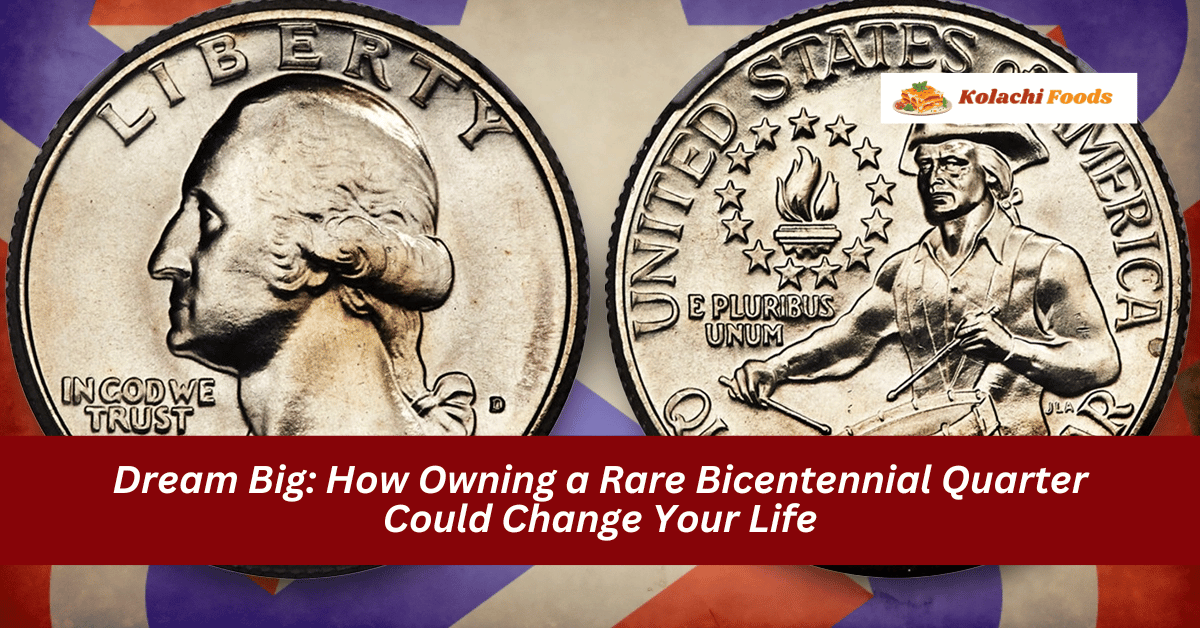The 1976 Bicentennial Quarter is a coin with a unique place in American history. Minted to celebrate the nation’s 200th birthday, this quarter doesn’t just hold sentimental value—it can also be worth a lot of money! While many of these coins are only worth 25 cents, certain rare versions can fetch thousands of dollars at auctions.
Let’s dive into the history of this special quarter, what makes some of them so valuable, and how owning one could change your financial future.
The History of the Bicentennial Quarter
The Bicentennial Quarter was created to honor the 200th anniversary of the United States’ independence, making it a coin with a rich historical background.
It was minted in 1975 and 1976, with more than 1.7 billion produced. What sets it apart from regular quarters is the dual date “1776-1976,” reflecting the nation’s founding year alongside its bicentennial celebration.
The coin features the iconic portrait of George Washington on the front (obverse) side. However, the reverse side is what makes it truly special. Instead of the usual eagle, the back shows a Colonial drummer boy, designed by Jack L. Ahr.
This unique design makes the Bicentennial Quarter a popular item among collectors.
Types of Rare Bicentennial Quarters and Their Values
While many of these quarters are worth no more than face value, certain types have become incredibly valuable. These coins stand out due to their rarity, minting errors, or silver content. Here are some of the most valuable Bicentennial Quarters:
1. 1976-S Silver-Clad Bicentennial Quarter
Minted in San Francisco, this coin contains 40% silver, unlike the regular copper-nickel quarters made in Philadelphia and Denver. The silver content alone makes it more valuable than a standard quarter, but its rarity and condition make it even more desirable. In 2019, one of these silver-clad quarters sold for an impressive $19,200!
2. 1976-D Doubled-Die Obverse Bicentennial Quarter
Minting errors can drastically increase the value of a coin, and the 1976-D Doubled-Die Obverse is a prime example. This error occurs when the die strikes the coin twice, creating a slight duplication of the design on the obverse side. A well-preserved example of this error coin was sold for $8,400 in 2023.
3. 1976-S Deep Cameo Proof Bicentennial Quarter
Proof coins are specially made to have a high level of detail, with a frosted image contrasted against a mirror-like background. The 1976-S Deep Cameo Proof is particularly prized by collectors. One of these coins was sold at auction for $2,760 back in 2007.
Factors That Influence the Value of Bicentennial Quarters
Not all Bicentennial Quarters are created equal, and several factors can influence their value. Here’s what makes some of them so valuable:
| Factor | Explanation |
|---|---|
| Mint Mark | Coins from the San Francisco Mint (marked with an “S”) are generally more valuable, especially if they contain silver or are proofs. |
| Condition | Coins in pristine, uncirculated condition (graded MS60 or higher) or proof coins (graded PR69 or PR70) can be worth significantly more. |
| Minting Errors | Errors like the doubled-die obverse or off-center strikes are rare and highly sought after by collectors. |
| Metal Content | Some Bicentennial Quarters contain 40% silver, which adds to their base value, particularly when silver prices are high. |
How to Identify and Grade Your Bicentennial Quarter
If you think you might have a valuable Bicentennial Quarter, it’s important to get it properly evaluated. Coins are graded using the Sheldon Scale, which ranges from Poor (P1) to Mint State (MS70) for regular coins, and from PR60 to PR70 for proof coins. Here’s how to evaluate the value of your coin:
1. Examine the Condition
Look for signs of wear. Coins that are uncirculated, meaning they haven’t been used in everyday transactions, will generally be in much better condition than circulated ones. Look for minimal scratches, dents, or signs of damage.
2. Seek Professional Grading
While you can make a rough estimate of a coin’s condition, professional grading services like the Professional Coin Grading Service (PCGS) can provide an official grade. A high grade from a reputable service can significantly boost the value of your coin when selling or auctioning it.
The Financial Impact of Owning a Rare Bicentennial Quarter
Owning a rare Bicentennial Quarter could have a significant financial impact. While most of these coins are only worth 25 cents, finding a rare version could mean a windfall. Some rare coins have sold for thousands of dollars at auction—enough to help pay off debt, make a down payment on a house, or even start a business.
In addition to being valuable in the present, rare coins can also appreciate over time. As fewer high-quality examples remain in circulation, their rarity increases, potentially making them worth even more in the future.
FAQs About Bicentennial Quarters
Q1: How do I know if my Bicentennial Quarter is valuable?
Check the mint mark, condition, and whether there are any minting errors. Silver-clad versions and coins from the San Francisco Mint are typically more valuable, especially if they’re in good condition or proof quality.
Q2: Where can I sell my Bicentennial Quarter?
You can sell rare coins through auction houses, online marketplaces like eBay, or directly to collectors. It’s often a good idea to get the coin graded first to maximize its value.
Q3: How much is a standard Bicentennial Quarter worth?
A standard Bicentennial Quarter, without any minting errors or special qualities, is generally only worth its face value of 25 cents.
Q4: What is the most valuable Bicentennial Quarter ever sold?
One of the most valuable Bicentennial Quarters is a 1976-S Silver-Clad quarter that sold for $19,200 at auction.
Q5: Can I still find Bicentennial Quarters in circulation?
Yes, it’s possible to find Bicentennial Quarters in circulation, though they are becoming rarer. Checking your change carefully might lead to a valuable find!
READ ALSO: Value of the 2009 Lincoln Penny, How Much is the Lincoln Penny Worth?

